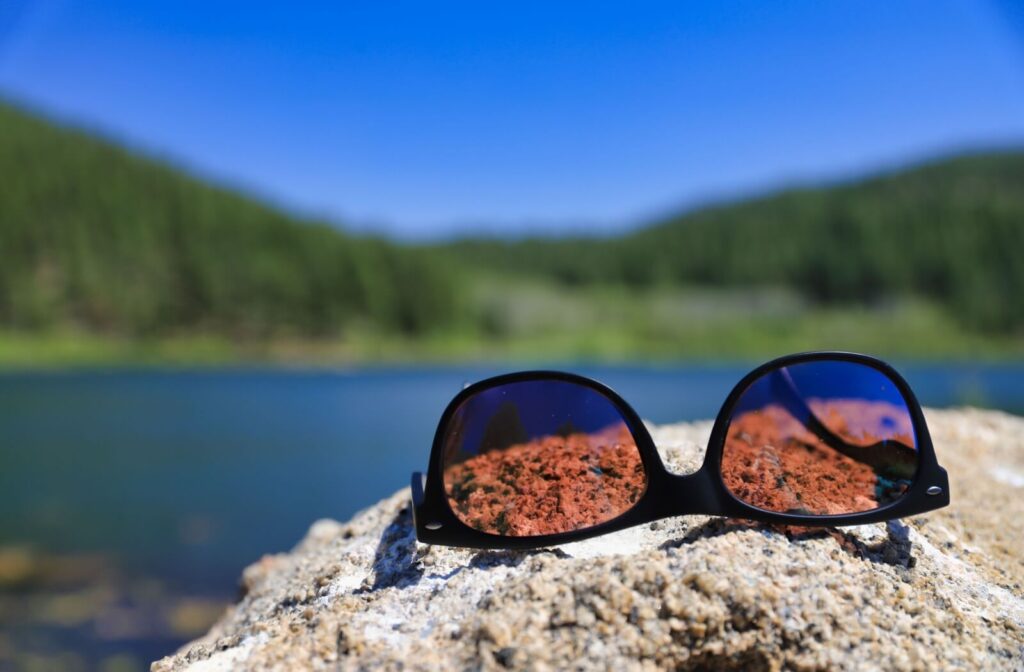Stepping outside can come with the feeling of warm sun on your skin, but it can also make you squint due to glare—sometimes, even with your sunglasses on! While all sunglasses should protect your eyes from UV rays (which increase your risk of developing eye conditions), polarized lenses reduce glare and improve visual comfort. But how do you know if your sunglasses are polarized?
To check if your sunglasses are polarized, look at a reflective surface through the lenses and tilt your head. If the glare diminishes or changes, your lenses are polarized.
Polarized sunglasses do more than just shield your eyes from sunlight; they also cut through blinding glare, making outdoor activities more enjoyable and safer.
How Sunglasses Protect Your Eyes
Before we discuss polarization, it’s important to understand how sunglasses protect your eyes from harmful UV rays. The sun’s ultraviolet rays are invisible, but they still have a significant impact on your eye health. Here’s a quick overview:
- UVA Rays: These aren’t blocked by the ozone layer and contribute to premature eye aging.
- UVB Rays: These are partially filtered by the atmosphere, but still reach the earth’s surface, increasing your risk of eye damage.
- UVC Rays: These are entirely absorbed by the ozone layer and do not pose a significant risk, unless you’re in space.
Consistent exposure to UV rays can lead to various issues such as:
- Damage to the cornea
- Cataracts
- Macular degeneration
- Growths, both benign and cancerous, in or around the eyes
Wearing sunglasses without proper UV protection can have unintended consequences. For example, dark-tinted lenses cause your pupils to dilate, allowing more light to enter—which, without UV protection, can lead to greater exposure to harmful rays. Quality sunglasses also help safeguard the delicate skin around your eyes from sun damage.
Not sure if your sunglasses offer adequate UV protection? Stop by and visit your optometrist, who can test your lenses and recommend eyewear that keeps your eyes healthy.
The Limitations of Non-Polarized Sunglasses
Non-polarized sunglasses are the most common type of tinted eyewear. They reduce brightness by dimming light intensity, often providing basic relief on sunny days. While they may block UV rays, glare caused by light reflecting off flat surfaces, like water, snow, and roads, typically remains.
What Are Polarized Sunglasses?
Polarized sunglasses take eyewear to the next level by actively reducing glare. These lenses are treated with a special filter that blocks horizontal light waves. Horizontal waves are the ones that reflect off of surfaces like roads and snow. By blocking this light, polarized lenses provide a clearer and more comfortable visual experience.
Key Benefits of Polarized Sunglasses:
- Sharper clarity: Minimization of glare helps you see details more clearly without affecting colour or depth perception.
- Improved comfort: By reducing strain on your eyes, you can enjoy longer outdoor time without fatigue.
- Greater precision: Focus on scenes, landscapes, or tasks that might be obscured by reflections.
For example, when driving, polarized sunglasses reduce glare from the road and other vehicles, improving visibility and safety.
Easy Tests to Check If Your Sunglasses Are Polarized
Sometimes, it’s not immediately obvious whether your sunglasses have polarized lenses. Fortunately, you can test them and find out!
- Reflection test: Hold your sunglasses up and look at a shiny, reflective surface, like a car windshield or the surface of a lake. Tilt your head at an angle. If the glare intensifies or diminishes, your sunglasses are polarized.
- Screen test: View an LCD screen, such as your phone or computer, through your sunglasses. Tilt your glasses slowly. If the screen appears darker or completely blacked out at certain angles, you’ve got polarized lenses.
Always purchase sunglasses from reputable retailers (like us!), so you can be sure they meet quality standards.

What Activities Are Polarized Sunglasses Good For?
Polarized sunglasses are perfect for activities and settings where glare is a significant concern. Here are some situations where they shine:
- Driving: Say goodbye to blinding reflections from car hoods and wet roads. Polarized glasses can make every drive safer and more comfortable.
- Boating: Whether you’re steering a speedboat or paddling a kayak, reducing glare from water can help you see more clearly.
- Fishing: Polarized sunglasses reduce reflections on the water, offering a tactical advantage for spotting fish.
- Outdoor sports or hikes: From cycling to hiking under a bright sky, polarized lenses keep your vision sharp and your eyes comfortable.
- Golf: Easier to follow the flight of the golf ball
When to Choose Non-Polarized Sunglasses
While polarized lenses offer impressive benefits, there are certain situations where unpolarized sunglasses may be the better choice, including:
- Snowy or icy roads: Polarized lenses can obscure shiny ice patches, making it harder to assess road conditions in winter.
- Using screens: Some LCD screens appear distorted or completely dark when viewed with polarized sunglasses, which can make working with digital devices a challenge.
- Operating equipment: Since many instrument panels use LCD screens, polarized lenses may be unsuitable for certain professions. For instance, they’re not recommended for pilots or operating heavy machinery.
Enjoy More of Your Sunny Days
Your eyes deserve the best protection, and the right pair of sunglasses can make all the difference. Whether you need help selecting polarized lenses or want to ensure your current sunglasses meet UV standards, Headwaters Optometry is here to help.
We’re passionate about helping you see the world clearly and comfortably. Book an appointment today, and we’ll help you find the perfect pair to keep your eyes healthy and your adventures glare-free!




